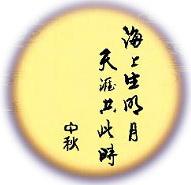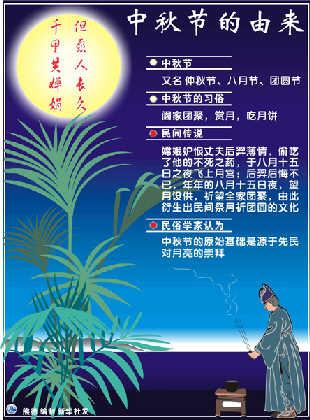Introduction of traditional festivals in China-Mid-Autumn Festival
"Moonlight is the brightest night in a year, when thousands of people enjoy it", "the moon, grown full now over the sea, brightening the whole of heaven" … The moon in the sky, human feelings, and the Mid-Autumn Moon, a special astronomical phenomenon, formed the unique Moon Festival and Reunion Festival in China.
 |
The 15th day of the eighth lunar month is the traditional Mid-Autumn Festival in China. This is the middle of autumn, so it is called Mid-Autumn Festival. This is also the second largest traditional festival in China after the Spring Festival.
 |
The origin of the Mid-Autumn festival
In China’s lunar calendar, a year is divided into four seasons, and each season is divided into three parts: Meng, Zhong and Ji, so Mid-Autumn Festival is also called Mid-Autumn Festival. The moon on August 15th is rounder and brighter than the full moons in other months, so it is also called Moon Festival, Autumn Festival, Mid-Autumn Festival, August Festival, August Festival, Moon Chasing Festival, Moon Worship Festival, Daughter’s Day or Reunion Festival, which is a traditional cultural festival popular among many ethnic groups in China. On this night, people look up at the bright moon in the sky like jade, and naturally look forward to family reunion. Wanderers who are far away from home also take this opportunity to pin their thoughts on their hometown and relatives. Therefore, Mid-Autumn Festival is also called "Reunion Festival".
It is said that the moon is closest to the earth this night, and the moon is the largest and brightest, so there is a custom of drinking and enjoying the moon from ancient times to the present; The daughter-in-law who goes back to her mother’s house will return to her husband’s house in the future, in order to express her happiness and good luck. In some places, such as Ningbo, Taizhou and Zhoushan, the Mid-Autumn Festival is scheduled for August 16th, which is related to Fang Guozhen’s change to "Lantern Festival on the 14th day of the first month and Mid-Autumn Festival on August 16th" in order to prevent attacks by officers and men of Yuan Dynasty and Zhu Yuantian. Besides, in Hong Kong, after the Mid-Autumn Festival, we will have another carnival in Izayoi called "Chasing the Moon".
The word "Mid-Autumn Festival" first appeared in the book "Zhou Li", and it was in the Tang Dynasty that a national festival really formed. In ancient times, our people had the custom of "autumn dusk and evening moon". The evening moon is to worship the moon god. In the Zhou dynasty, every mid-autumn night was held to welcome the cold and offer sacrifices to the moon. Set up a big incense table, and put moon cakes, watermelons, apples, red dates, plums, grapes and other sacrifices, among which moon cakes and watermelons are absolutely indispensable. Watermelon has to be cut into lotus shapes. Under the moon, put the moon statue in the direction of the moon, and the red candle burns high. The whole family worships the moon in turn, and then the housewife cuts up the reunion moon cake. The person who cuts should calculate in advance how many people there are in the whole family, both at home and in other places, and they should be counted together. They should not cut more or less, and the size should be the same.
As for the custom of eating moon cakes in the Mid-Autumn Festival, it was formed in the Ming Dynasty. Tian Rucheng, a writer in the Ming Dynasty, wrote in "Notes on the Tour of the West Lake": "August 15th is called Mid-Autumn Festival, and the folks take mooncakes as a legacy to get together". Shen Bang, a historian of the Ming Dynasty, wrote in Miscellanies of Wan Department that "the flour cakes are different in size, and they are different in size. The cake is filled with fruit, and the name is different. There is a cake worth hundreds of dollars. " The book also introduces the production process at that time, which has reached a high level. The moon cakes used for the moon in the Beijing Palace are "more than feet in diameter from bottom to top and weigh two pounds." Later, with the evolution of the past dynasties, the varieties and patterns of moon cakes became more and more abundant, the production technology was updated, and the flavor was more. Eating moon cakes on August 15th has become an ancient and very meaningful tradition of the Chinese nation.
In the Tang Dynasty, it was quite popular to enjoy and play with the moon in the Mid-Autumn Festival. In the Northern Song Dynasty, on the night of August 15th, people all over the city, rich and poor, old and young, put on adult clothes, burn incense and express their wishes to Yue Bai, and pray for the blessing of the moon god. In the Southern Song Dynasty, people gave each other mooncakes as a token of reunion. In some places, there are activities such as dancing grass dragons and building pagodas. Since the Ming and Qing Dynasties, the custom of Mid-Autumn Festival has become more popular, and many places have formed special customs such as burning incense, planting Mid-Autumn Festival trees, lighting tower lanterns, putting sky lanterns, walking on the moon and dancing dragon.
Today, the custom of playing under the moon is far from prevailing in the old days. However, feasting to enjoy the moon is still very popular. People drink asking for the moon to celebrate a better life, or wish their distant relatives healthy and happy, and "have a beautiful life together" with their families.
There are many customs and forms of Mid-Autumn Festival, but they all entrust people with infinite love for life and yearning for a better life.